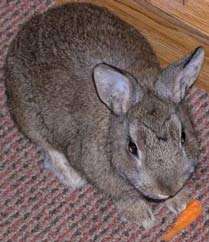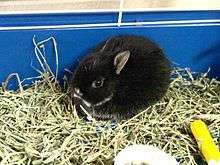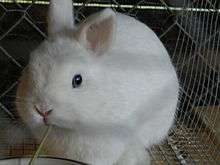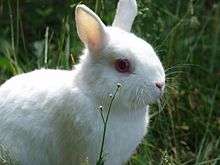Netherland Dwarf rabbit


The Netherland Dwarf is a popular breed of domestic rabbit (Oryctolagus cuniculus) originating in the Netherlands. Smaller than most rabbit breeds, Netherland Dwarf rabbits weigh 500 g to 1.13 kg (1.1 lbs to 2.5 lbs) and are usually kept as pets or exhibition animals. They are not typically used as sources of meat or fur because of their small size.
Many rabbits sold in rabbit shows are Netherland Dwarfs, Netherland Dwarf-derived breeds (often referred to simply as dwarf breeds), or Netherland Dwarf crosses. Their popularity as pets stems from their babyish appearance. Many people also use Netherland Dwarfs for showing. Despite being smaller than other breeds Netherland Dwarfs are very active and, as with all rabbits, need a good amount of space to move around and exercise.
History
The Netherland Dwarf breed was first produced in the Netherlands in the early 20th century. Small Polish rabbits were bred with smaller wild rabbits;[1] after several generations the resulting animal was a very small domestic rabbit available in a wide variety of colors and patterns. Netherland Dwarfs were first imported into the United Kingdom in 1948.[1] In the 1960s and 1970s the United States imported its first Netherland Dwarf rabbits. The breed was accepted by the American Rabbit Breeders' Association in 1969 using a modification of the British standard.[1]
Early dwarfs, even into the 1970s and 1980s, had fearful and sometimes aggressive temperaments. This was a result of breeders selecting wild breeding animals for their size. The first dwarf rabbits behaved more like these wild rabbits than domestic animals and were not good pets. However, through generations of selective breeding, the modern Netherland Dwarf has become a gentle, friendly pet rabbit, though it still can retain a more energetic disposition than larger breeds.

Appearance

The Netherland Dwarf's head and eyes are disproportionately large with respect to its body, (due to genetic dwarfism) and its ears are small and carried high on the head. Additionally, the face is rounded and shortened. You will also find that they have a compact and rounded body. These features, part of the animal's dwarfism, cause them to look infantile even into adulthood.

Dwarf crosses frequently retain some of these characteristics, depending on the breed the dwarf is crossed with. However, crosses rarely look as babyish as the purebred dwarfs and are usually somewhat larger.
Purebred Netherland Dwarfs exist in an extensive variety of colors, including Red Eyed White, Blue Eyed White, Black, Blue, Chocolate, Lilac, Red, Siamese Sable, Siamese Smoke, Sealpoint, Blue Point, Chocolate Point, Tortoiseshell, Agouti, Red Agouti, Opal, Cinnamon, Lynx, Chinchilla, Squirrel, Tan, Marten Sable, Marten Smoke, Black Otter, Blue Otter, Chocolate Otter, Lilac Otter, Fox, Orange, Fawn, Hotot, Himalayan, Harlequin, Magpie, Broken, Butterfly, Mantle and EMD.
Netherland Dwarfs as pets
Behavior
Netherland Dwarf rabbits have the same basic behavioral traits as dogs or cats. They can be litter-trained because they have a natural tendency to choose the same spot for their droppings.
Netherland Dwarfs can be skittish, wild, and/or of a disagreeable nature. This is a leftover stereotype from the beginnings of the breed. This has changed through selective breeding; however, they are skittish and aloof. They are extremely active and energetic, requiring more exercise than most rabbits. They also have a higher tendency towards nervousness and stress. As with any species, disposition will vary from individual to individual.
Due to their size and overall disposition, Netherland Dwarfs do not make good pets for children. There is often a mismatch with small children, because they like to play with the pet or pick it up to cuddle with it. Dwarf rabbits don't like to be picked up or held tightly; and they can bite, scratch or struggle wildly if the child does so. This often leads to accidents if the child drops them out of fright, leading to major injuries because a rabbit has very fragile bones. Larger breeds of rabbits are recommended for children, because they have fewer issues with temperament. However, it should be taken into account that a rabbit is never a low-maintenance pet. It requires several hours a day of supervised exercise and human interaction. This serious commitment may prove too much for the child, and often the child is disappointed that the rabbit doesn't want to play.
However, dwarf rabbits can make excellent pets for adults, even for people with a disability. They thrive in a quiet, stable househould with plenty of human interaction. They are trainable, quiet and clean. Because of their small size dwarf rabbits are easily handled when necessary. Grooming needs are minimal, but the rabbit definitely enjoys a daily brushing. Time is needed to bond with the rabbit and to build trust, because Dwarf breeds are more nervous and aloof than larger breeds. It's important that new rabbit owners educate themselves on rabbit behaviour and how to gain their trust. However, when the rabbit has bonded with their owner they make very affectionate pets. They will seek out their owner for cuddles and grooming, and they can be trained to respond to their name.
Diet
A Netherland Dwarf needs 2-3 ounces of alfalfa pellets a day and an unlimited amount of timothy hay. As with all rabbits, an important part of the diet should consist of hay and pellets. These should be available at all times and are essential for the rabbits digestive system. Do not give cut grass as it ferments quickly and may cause digestive problems. A small amount of vegetables may be given. Dark leafed vegetables are good. Root vegetables such as carrots and parsnips etc. and fruit are high in sugar and should not be given often or in large amounts. If you wish to feed them fruit, give them low-sugar fruits, like apple. Only certain varieties of lettuce may be given. Romaine and rocket and some of the darker leaf varieties are OK but check first if you are unsure, with a vet or the Rabbit Welfare Assoc. whose knowledge about rabbits is excellent. If in ANY doubt avoid lettuce altogether as feeding unsuitable varieties may affect your rabbits health . Water should be available at all times. A regulated amount of pelleted food should be given. NOT muesli style rabbit food as this can kill a rabbit by upsetting their GI system. Rabbits GI systems are very sensitive and they can easily go into something called GI stasis, from which many don't recover. Sudden changes to a rabbit's diet can cause digestion problems. If you have to change their diet do it slowly over a period of weeks. Incorrect feeding of any rabbit can lead to digestion problems such as diarrhea and gut stasis which can result in serious illness and possibly death. Consult a vet or animal charity for advice if you are in any doubt.
A very important aspect of rabbit care is proper diet. Many owners unintentionally fail at this point and that often spells disaster for their pet. Netherland Dwarfs have a digestive system even more sensitive than most breeds. The best diet consists of fresh, good quality rabbit .pellets fed in limited amounts—1/8 cup per pound of body weight—with unlimited access to hay for an adult and junior rabbit. look for really dry and green hay. Chopped safe vegetables could also be given, at 2 cups or more per 6 pounds of body weight.[2]) It is crucial that the pellets be fresh and stored for no longer than six months, do not use pellets which are moldy or have been contaminated. As pellets age they lose important nutrients, and a rabbit’s system will become susceptible to disease. The owner should also check the label for the percentages of protein, fiber, and fat. The National Research Council lists minimum rabbit nutrient requirements for a maintenance diet as 14%-16% crude fiber, 2% fat, and 12% protein. It is best to feed a pellet that is higher in fiber (16-20%) and lower in protein (14-15%) and fat (2-3%) to a pet rabbit. Once you find a good brand, stick with it; frequent changes in diet can cause digestive problems. If you need to change brands, be sure to mix the new feed in with the old and increase the amount of new to old over a week's time so the rabbit can adjust.
Netherland Dwarfs generally don't require much feed. However, it is important to adjust for each individual to avoid malnourishment or obesity as well as adjusting for age. It is also important not to overfeed a Netherland Dwarf. Hay, however, can and should be given in unlimited amounts.[2] access to water is always required.Dwarfs are naturally compact, so learn how to tell whether they are overweight before putting them on a smaller diet.
Suitable and unsuitable fresh foods
Especially recommended vegetables with greens: cucumber, carrots, fennel, celeriac, turnip, and broccoli
Especially recommended herbs and medicinal plants: basil, borage, watercress, dill, chamomile, chervil, lovage, lemon balm, oregano, parsley, and yarrow
Recommended vegetables/tubers: squash, parsnip, chicory, zucchini, parsley root, only leaves of corn,
Not suitable/never feed these: eggplant, celery, any type of lettuce, avocado, legumes (peas, lentils), radishes (root), soybeans, leeks, ornamental gourds, onions, rhubarb; spinach. Certain types of Lettuce are hazardous for rabbits because of the high amount of water, which can cause diarrhea. Stringy foods are also bad for rabbits, including celery, asparagus, and rhubarb.
Poisonous: raw potatoes and potato leaves, onions, green tomatoes, tomato leaves, raw beans [3]
Dwarf breeds

Rabbit breeds derived from breeding larger rabbits with the Netherland dwarf (or any rabbit with a dwarf gene) are known as dwarf breeds. Most smaller breeds, like the Mini-Rex, the Jersey Wooly, and the Holland lop, are results of such breedings. Generally dwarf breeds are slightly larger than the typical Netherland dwarf, not growing larger than 4 to 5 lb (1.8 to 2.3 kg). Most have shortened faces compared to larger rabbits, and some even preserve the rounded head, large eyes, or small ears of the Netherland dwarf. These features make them look little. Specifically, the Netherland Dwarf body should be round, compact, and equally broad from front to back. Dwarf rabbits also have short legs and a large head in relation to the body. Their foreheads are broad and they have well-developed muzzles. Furthermore, the eyes are large and prominent. Their ears, unlike that of the Hop, are erect and close together, reaching between one and three inches in length. They have to be shorter than 2 inches and a half (ARBA), if not, this is a disqualification from competition in the netherland dwarf breed. Dwarf rabbits typically weigh 2 to 2.5 pounds according to ARBA.[4]
Most dwarf breeds are intended to bring a specialized characteristic, such as a specific fur type, into a smaller rabbit. Mini-Rex were created through the breeding of dwarfs with Rex rabbits, a fur breed with a short, plush coat, and retain both the dwarf's size and the Rex fur. Jersey Woolies are a dwarf version of the Angora rabbit, a wool-producing breed. Lop-eared rabbit breeds, interbred with dwarfs, were used to create Holland Lop. Despite its name, the Mini Lop is not a dwarf breed.
Breeding
The gene (symbol Dw) responsible for the common appearance of the dwarf was discovered in the United States during the beginning of the 20th century. When two "true dwarfs" (both buck and doe) are bred, the genetic pattern which makes them "true dwarfs" (Dwdw) ensures that 25 percentage of their offspring will inherit the lethal genetic combination dwdw. These offspring, often called "peanuts" by rabbit breeders, are destined to struggle with life for up to three weeks, and then to die. Reasons behind the death are unknown, but it is believed that peanuts have underdeveloped digestive tracts. The condition is 100% fatal, although if fed by hand every hour and kept warm it is possible for a peanut to survive, even though it will be handicapped for its entire life. Many ethical breeders humanely euthanize peanuts upon finding them soon after birth. Peanuts are easily distinguished from non-peanuts; they have extremely pinched hindquarters, a bulbous head, and their ears are often set further back than normal (sometimes almost onto the neck).
If two true dwarfs are bred, the statistical result will be 25% fatal 25% false, and 50% true. The actual numbers of true/false/peanuts in a real litter varies. "False Dwarfs" tend to have longer bodies, longer/larger ears, longer faces, and are mostly heavier than the 2.5 pound maximum weight for showing. While false dwarfs (referred to as BUD' s by breeders, BUD meaning big ugly doe) do not make good show rabbits, does from a good background are vital to a breeder's program. They have the same "good genes" as a true dwarf and are capable mothers, possibly even having larger and more successful litters than true dwarfs. Also False Dwarfs are unable to produce peanuts. Their litters will be 50% false dwarfs and 50% true dwarfs if they are bred to a true dwarf buck.False dwarfs are easily judged for quality as the traits are generally the same, only bigger. Ear thickness/shape, fullness of hindquarter, topline, and other traits are the same.
It is common practice among Netherland Dwarf breeders to breed a proven show quality true dwarf buck to a quality false dwarf doe. This eliminates the chance of peanuts and yields quality offspring. The chances of false dwarfs is higher, but those offspring generally go toward breeding (some false dwarf bucks have proven themselves valuable to a breeding program) or are sold as pets. Usually false dwarf bucks are not kept by breeders.
See also
Notes
- 1 2 3 American Rabbit Breeders Association (2000). Official Guide Book: Raising Better Rabbits & Cavies. Bloomington, IL: American Rabbit Breeders Association, Inc. p. 65.
- 1 2 http://www.bio.miami.edu/hare/diet.html
- ↑ Wegler, Monika. "Fresh Greens and Good Hay." My Dwarf Rabbit. Hauppauge, NY: Barron's, 2008. 67. Print.
- ↑ Wegler, Monika. "The Dwarf Breeds." My Dwarf Rabbit. Hauppauge, NY: Barron's, 2008. 26-31. Print.
External links
- American Netherland Dwarf Rabbit Club
- Dwarf Rabbits Articles
- Netherland Dwarf Rabbit Breed History
- Breeds of Rabbits Chart